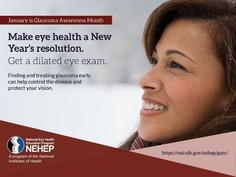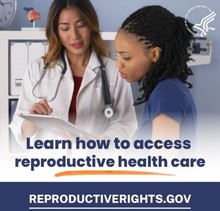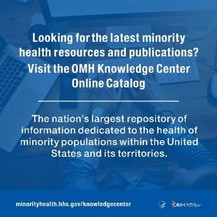
January is Glaucoma Awareness Month, and the HHS Office of Minority Health (OMH) joins the National Eye Institute (NEI) to spread the word about how to find glaucoma early — and how people with glaucoma can protect their vision.
Glaucoma often has no early warning signs. It has no symptoms and causes no pain, but it can be detected early through a comprehensive dilated eye exam. You may be eligible to have most of the cost of an eye exam paid for by Medicare.
According to the NEI, anyone can get glaucoma, but those at higher risk include:
- Everyone over age 60, particularly Hispanics/Latinos
- African Americans over age 40
- People with a family history of glaucoma
Visit NEI’s National Eye Health Education Program website to find fact sheets, infographics, social media graphics, videos and webinars, and the Talk With Your Doctor About Glaucoma guide, also available in Spanish.
|

Cervical cancer was once a leading cause of cancer death for women in the United States. According to the Centers for Disease Control and Prevention (CDC), Hispanic/Latina women have the highest cervical cancer rates, followed by Black/African American women.
Today, screening and prevention have significantly reduced the impact of this form of cancer. Still, nearly 14,500 women in the United States received a diagnosis of cervical cancer and more than 4,200 died from the disease last year, according to the National Cancer Institute.
This Cervical Cancer Awareness Month, OMH encourages you to get vaccinated for HPV early and have regular screening tests to help prevent cervical cancer. Low-income, uninsured, and underinsured women can access cervical cancer screenings and diagnostic services through the CDC’s National Breast and Cervical Cancer Early Detection Program.
|

This week is National Healthy Weight Week, a time to encourage everyone to focus on healthy eating, physical activity, optimal sleep, and stress reduction to achieve and maintain a healthy weight. According to the CDC, obesity affects more than 40 percent of Americans, placing them at higher risk for heart disease, stroke, type 2 diabetes, and certain types of cancer.
Obesity affects some groups more than others. Data from the CDC shows that Black/African American adults had the highest prevalence of obesity (49.9 percent), followed by Hispanic/Latino adults (45.6 percent) and Asian adults (16.1 percent). Take charge of your weight and health with the following resources:
- The National Institute of Diabetes and Digestive and Kidney Diseases (NIDDK)’s Changing Your Habits for Better Health, also available in Spanish, outlines four stages you may go through when changing health habits such as eating and physical activity.
- NIDDK’s Staying Active at Any Size, also available in Spanish, provides guidelines and tips for people who are overweight or have been inactive for a long time.
- The U.S. Department of Agriculture (USDA) MyPlate website and Start Simple with MyPlate app include healthy eating tips organized by food groups and simple recipes, such as meals tailored for Asian, Hispanic/Latino, American Indian/Alaska Native, and Middle Eastern communities.
- The Office of Disease Prevention and Health Promotion (ODPHP) Move Your Way Healthy Eating Integration Resources, also available in Spanish, includes six stories that speak to how different individuals integrate physical activity and healthy eating into their daily lives.
|

Reproductive health care, including access to birth control, is an essential part of health and well-being. HHS is committed to providing accurate and up-to-date information and resources about access to and coverage of reproductive health care.
The Office of Population Affairs (OPA) funds more than 3,200 Title X family planning clinics that deliver high-quality reproductive health care across the nation. These public and private nonprofit health and community-based clinics play a critical role in ensuring access to a broad range of family planning services, including contraceptive education, counseling, and methods.
In addition to birth control, Title X clinics also provide access to a broad range of family planning services, including contraceptive education, counseling, and methods. These confidential services are free or low-cost and available to anyone who needs them.
Visit ReproductiveRights.gov to learn more about your rights, health insurance coverage, and where care is available, and find a Title X family planning clinic near you.
|

This month, in recognition of National Healthy Weight Week, the OMH Knowledge Center is featuring a collection of publications related to healthy weight. This collection includes documents, articles, and fact sheets ranging from childhood obesity, lifestyle determinants, racial disparities, and more.
These resources are available for free through the online catalog here.
Looking for more information on a topic included in this collection? View our search tips page for guidance on searching the online catalog, or contact the OMH Knowledge Center directly for research assistance.
|
|